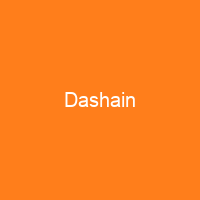Dashain is celebrated by the Hindus of Nepal and the Nepali language speaking people of the Darjeeling hills, Sikkim, Siliguri, Assam and other North-Eastern states of India. The festival falls in September or October, starting from the shukla paksha of the month of Ashwin and ending on Purnima, the full moon. For other Hindus, this festival symbolizes the victory of Ram over Ravan as recounted in the Ramayana.
About Dashain in brief
 Dashain is celebrated by the Hindus of Nepal and the Nepali language speaking people of the Darjeeling hills, Sikkim, Siliguri, Assam and other North-Eastern states of India. The festival falls in September or October, starting from the shukla paksha of the month of Ashwin and ending on Purnima, the full moon. The first nine days of Dashain symbolize the battle which took place between the different manifestations of Durga and Mahishasura. The tenth day is the day when Durga finally defeated him. For other Hindus, this festival symbolizes the victory of Ram over Ravan as recounted in the Ramayana. Among the Newar of the Kathmandu Valley, during the Dashain festival, a popular Newari festival called Mohani, is celebrated as the most important festival of Nepal Sambat calendar year. Dashain is also important for its emphasis on family gatherings as well as on a renewal of community ties, highlighted by special family dinners called Nakhtyā and various communal processions of deities called Jātrā. The most anticipated festival in Nepal, Bhutan, Burma, and North Indian hills. Phulpati is a major celebration occurring on the seventh day, on this day, the royal Kalash, banana stalks, jam, sugar cane and red cloth are tied with red cloth. Hundreds of government officials from Gorkha gather together in Tundikhel to observe the ceremony.
Dashain is celebrated by the Hindus of Nepal and the Nepali language speaking people of the Darjeeling hills, Sikkim, Siliguri, Assam and other North-Eastern states of India. The festival falls in September or October, starting from the shukla paksha of the month of Ashwin and ending on Purnima, the full moon. The first nine days of Dashain symbolize the battle which took place between the different manifestations of Durga and Mahishasura. The tenth day is the day when Durga finally defeated him. For other Hindus, this festival symbolizes the victory of Ram over Ravan as recounted in the Ramayana. Among the Newar of the Kathmandu Valley, during the Dashain festival, a popular Newari festival called Mohani, is celebrated as the most important festival of Nepal Sambat calendar year. Dashain is also important for its emphasis on family gatherings as well as on a renewal of community ties, highlighted by special family dinners called Nakhtyā and various communal processions of deities called Jātrā. The most anticipated festival in Nepal, Bhutan, Burma, and North Indian hills. Phulpati is a major celebration occurring on the seventh day, on this day, the royal Kalash, banana stalks, jam, sugar cane and red cloth are tied with red cloth. Hundreds of government officials from Gorkha gather together in Tundikhel to observe the ceremony.
Then there is a majestic display of the Nepalese Army along with a celebratory firing of weapons that continues for ten to fifteen minutes. The event ends in a time where the king is taken to the Hanuman Dhoka Royal Palace where a parade was headed towards the royal palace. It is the longest and the most auspicious festival in the Bikram Sambat and NepalSambat annual calendars, celebrated by Nepalese people, along with their diaspora throughout the globe. The ritual is performed at a certain auspicious time which is determined by the astrologers. The goddess Durga is believed to reside in the vessel during Navratri. The Kalash is kept away from direct sunlight and holy water is offered to it every day so that by the tenth day of the festival the seed will have grown to five or six inches long yellow grass. This sacred grass is known as jamara. Traditionally, outsiders are not allowed to enter the room where all this is done and it is called Dashain Ghar. A family member worships the Kalash twice every day, once in the morning and then in the evening. On this day theKalash is filled with holy water and is then sewn with barley seeds. Then the Kalasha is put in the center of a rectangular sand block, also seeded with grains.
You want to know more about Dashain?
This page is based on the article Dashain published in Wikipedia (as of Dec. 04, 2020) and was automatically summarized using artificial intelligence.







